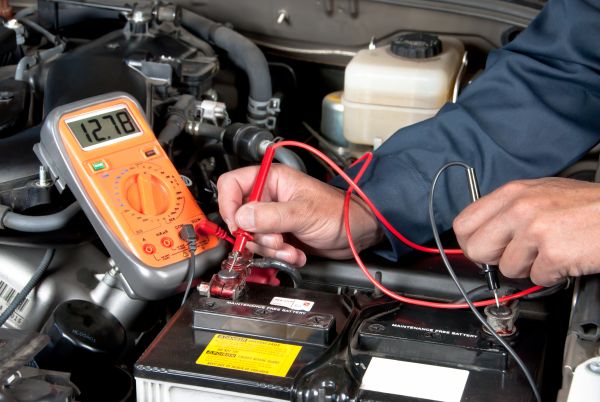 Imagine you’re about to start your car, but it doesn’t roar to life—your battery is dead. A well-maintained car battery is essential for avoiding such frustrating situations and ensuring your vehicle performs reliably. Understanding how to keep your car battery in optimal condition not only extends its life but also saves you time and money in the long run.
Imagine you’re about to start your car, but it doesn’t roar to life—your battery is dead. A well-maintained car battery is essential for avoiding such frustrating situations and ensuring your vehicle performs reliably. Understanding how to keep your car battery in optimal condition not only extends its life but also saves you time and money in the long run.
Car batteries are often overlooked until problems arise, yet they are crucial for any car’s functionality. Regular maintenance, from cleaning the terminals to managing electronic usage, plays a vital role in preserving your battery’s health. Staying informed on practices like checking fluid levels and protecting against extreme weather ensures your car remains ready when you are.
In this article, you’ll discover the top 10 tips for keeping your car battery in prime shape. From simple maintenance hacks to when to seek professional assistance, Pete Nelson Automotive‘s guide will help you ensure your car is always ready to hit the road.
1. Clean and Secure Battery Terminals
To maintain a healthy battery, keeping the terminals clean and secure is crucial. Corroded battery terminals can block the flow of electricity, leading to electrical issues in your car. Here’s how you can clean them effectively:
1. Gather Materials:
- Baking soda
- Water
- Hard-bristle brush
- Terminal spray
2. Cleaning Steps:
- Disconnect the Battery: Start with the negative cable, then the positive. Keep cables from touching metal to prevent electrical hazards.
- Create a Solution: Mix equal parts baking soda and water.
- Scrub the Terminals: Use the hard-bristle brush and the baking soda mix to remove corrosion.
- Rinse and Dry: Ensure the terminals are dry to prevent moisture-related corrosion.
3. Reconnect and Protect:
- After cleaning, reconnect the positive cable first, then the negative.
- Apply a terminal spray to protect against future corrosion.
Regular inspection and cleaning of battery terminals can extend the battery’s life by reducing resistance. Keep an eye out for signs of corrosion such as a white or blue powder on the terminals. Following these steps ensures proper maintenance and keeps your vehicle’s electrical components in top shape.
2. Regular Voltage Testing
Regular voltage testing of your car battery is crucial for maintaining battery health and avoiding sudden failures. By regularly checking the voltage, you can catch potential issues before they lead to a dead battery. This can be done during routine car services by a mechanic at Pete Nelson Automotive or by using a voltmeter at home.
Tools You Can Use:
- Voltmeter: Easy to use for home checks.
- Multimeter: Offers more detailed voltage information.
Key Benefits:
- Early Detection: Identifies potential battery problems before they worsen.
- Roadside Safety: Helps avoid unexpected breakdowns.
- Optimal Performance: Ensures your car’s electrical components remain in good condition.
Regular assessments can help decide when a battery replacement is necessary. For ease of understanding, here’s a simple voltage guide:
|
Voltage Range |
Battery Status |
|---|---|
|
12.6V or more |
Fully charged |
|
12.4V – 12.6V |
Normal |
|
Below 12.4V |
Needs charging/replacement |
By keeping an eye on your battery voltage, you ensure your car stays ready for any journey, whether in extreme temperatures or mild climates.
3. Inspecting Fluid Levels
When inspecting fluid levels in a lead-acid wet cell battery, it’s important to prioritize safety. Always wear gloves and protective eyewear. Here’s a quick guide to help ensure your battery stays in top condition:
Steps to Inspect Fluid Levels:
- Gather Materials: Get a flathead screwdriver and distilled water.
- Remove Vent Caps: Carefully use the screwdriver to lift the caps.
- Check Levels: Make sure the water covers the battery plates.
- Add Water: If needed, add only distilled water to avoid diluting the electrolyte.
Why Use Distilled Water?
- Tap water contains minerals that can harm battery performance. Distilled water ensures a healthy battery.
Here’s a quick reference:
|
Step |
Action |
|---|---|
|
Safety Gear |
Wear gloves and eyewear |
|
Tools Needed |
Flathead screwdriver, distilled water |
|
Water Check |
Ensure water covers battery plates |
|
Water Addition |
Use distilled water only |
Regular inspection of fluid levels can prevent battery failure and extend battery life. Remember to replace vent caps securely after checking. Proper maintenance keeps your car running without dead battery issues.
4. Importance of Regular Driving
Regular driving is crucial for maintaining a healthy car battery. When you drive for at least 20 minutes once a week, you’re doing more than just getting from point A to B. You’re allowing the car alternator to recharge the battery, keeping it at an optimal charge level and avoiding battery drain.
Tips for Maintaining Battery Health:
- Take Regular Drives: Aim for at least one 20-minute drive each week.
- Avoid Short Trips: They don’t let the alternator recharge the battery fully.
- Idle if Necessary: If regular driving isn’t possible, let the car run for 20 minutes without moving.
Leaving a car idle for extended periods can lead to a dead battery. Consistent recharging is vital. If your car sits unused for a month or two, the battery may die without the juice to start the car. Regular driving also prevents electrical issues and extends battery life.
Remember, a charged battery means fewer chances of battery failure or electrical issues. Keep that battery warm and ready, especially in cold climates. For more battery maintenance tips, see the details in the table below.
|
Activity |
Impact on Battery Health |
|---|---|
|
20-minute Weekly Drive |
Optimal Charging |
|
Short Trips |
Insufficient Charging |
|
Idle for 20 Minutes |
Maintains Charge |
5. Utilizing a Battery Maintainer
A battery maintainer is a great tool for keeping stored or unused batteries in top condition. It’s especially useful for vehicles that aren’t used regularly, like motorcycles or boats. By delivering power only when needed, a battery maintainer ensures that the battery remains healthy and doesn’t become under- or overcharged.
Benefits of a Battery Maintainer:
- Prevents Damage: Keeps batteries from staying in a discharged state, avoiding irreversible damage.
- Automatic Monitoring: Monitors voltage levels and adjusts the charge to extend the battery’s life.
- Versatile Use: Suitable for cars, motorcycles, and marine batteries during extended periods of non-use.
When you leave a battery unattended, it’s at risk. A battery maintainer helps you avoid this by making sure the battery’s charge is just right. It’s an investment in battery health that saves you from costly replacements and issues.
Quick Tip: Always check that the battery maintainer is compatible with your battery type to prevent any electrical issues. A small step like this can make all the difference in achieving a healthy, long-lasting battery.
6. Managing Electronic Usage
Modern vehicles come with many electronic accessories. To extend your battery life, it is wise to minimize their use when the engine is off. This conservation helps avoid a dead battery.
Here are some key tips:
- Turn off unnecessary electronics: Switch off GPS and entertainment units when the vehicle is not running. This reduces strain on the battery.
- Avoid using air conditioning and radios when the engine is off: These devices can cause battery drain.
- Be aware of parasitic drain: Electrical components can still drain power even if the car is off. This can lead to low battery voltage.
- Turn off accessories during starting: Disable seat warmers and phone chargers before you start the engine to conserve battery power.
Always remember, a healthy battery is crucial for proper maintenance of your car’s electrical components. By managing electronic usage, you can reduce the risk of battery failure and extend the battery’s life. Consider keeping a voltage reader handy to monitor your battery health regularly.
7. Protecting Against Extreme Temperatures
Extreme temperatures can greatly impact a car battery’s performance and lifespan. In cold climates, using an insulation blanket helps prevent the battery from freezing. Conversely, in hot weather, parking in shaded areas or garages keeps the battery environment cooler.
|
Weather Condition |
Battery Protection |
|---|---|
|
Cold Conditions |
Insulation blanket |
|
Hot Weather |
Shade or garage parking |
Modern vehicles often limit airflow under the hood. This makes insulation vital in maintaining battery health, as natural ventilation is reduced. Using a trickle charger ensures the battery stays charged, especially during extended periods of extreme temperatures.
Tips for Extreme Temperature Protection:
- Use insulation both in cold and hot climates to prevent battery failure.
- Park in shaded or cool places during the heat to reduce overheating.
- Regularly charge the battery with a trickle charger to keep it ready and prevent electrical issues.
By following these battery maintenace tips, you can extend the battery’s life and avoid potential problems.
8. Choosing a Fresh Battery
Selecting the right car battery is crucial for optimal performance and longevity. Cheap batteries might save money upfront but could disappoint in the long run, especially in cold weather.
When choosing a battery, understand the types:
|
Battery Type |
Features |
|---|---|
|
Lead-acid |
Cost-effective but needs regular checking |
|
AGM |
More durable and maintenance-free |
|
Lithium-ion |
Lightweight with a longer life |
Extreme temperatures, either hot or cold, can affect battery life. That’s why quality matters. Also, proper storage is crucial. When not using your car for extended periods, consider a battery maintainer or trickle charger to preserve its charge.
Here’s a quick checklist when buying a battery:
- Check compatibility with your vehicle
- Consider your climate
- Opt for reliable brands
Maintaining proper fluid levels and keeping the battery terminals clean can prevent premature battery failure. By following these steps, you’ll ensure a healthy battery and minimize electrical issues.
9. Incorporating Battery Care into Routine Maintenance
Ensuring effective car battery maintenance is crucial for the longevity of your vehicle. Regular inspections should focus on checking for corrosion, damage, and ensuring that battery terminals are tight and clean. This ensures smooth electrical connections and prevents potential battery failure.
Incorporating battery care into your routine maintenance boosts your vehicle’s overall performance. For cars not used frequently, investing in a quality battery charger or trickle charger is a smart choice. This helps maintain battery voltage, keeping it healthy and extending its lifespan.
Below are some essential battery maintenance tips:
- Check for Corrosion: Keep the battery tray clean and use baking soda to clean any signs of corrosion on the battery terminals.
- Fluid Levels: Regularly monitor battery fluid levels and top off with distilled water if necessary.
- Replace When Necessary: Batteries older than 3-5 years or showing weakness should be replaced to avoid breakdowns.
- Use a Hold-Down System: Prevent damage from vibration by securing the battery properly.
By implementing these steps, you enhance your battery’s reliability, ensuring it remains a vital part of your vehicle’s performance.
10. Seeking Professional Advice When Needed
Proper car battery maintenance includes knowing when to call in the experts. While routine tasks like cleaning terminals or checking fluid levels can be done at home, more complex issues—such as hidden internal wear or voltage irregularities—are best diagnosed by a professional. That’s where Pete Nelson Automotive comes in. Located in Sun City, our experienced technicians offer comprehensive battery checks, diagnostics, and replacements to ensure your vehicle stays reliable year-round. Don’t wait for your battery to fail—call us at (623) 974-4723 to schedule a battery inspection today. Reliable starts begin with expert care.


